The 1960s were a crazy time for basketball cards. There were no reliable releases available for fans. Topps got out of the game after the late 1950s and would only really return to it at the end of the decade. Meanwhile, Fleer and Kahn’s Wieners (yup, really) released important sets only for a while.
Despite the unreliability of the releases, the quality of just about every set that was produced was incredibly high. The 1960s arguably feature the most beautiful basketball cards ever made. There are a few key rookie cards in the decade, like Wilt Chamberlain, Bill Russell, Jerry West, and Lew Alcindor (later known as Kareem Abdul-Jabar). And high-graded versions of their cards go for healthy prices. But below that mark, many of the most jaw-dropping designs are not all that expensive.
There is more good news. The basketball cards vintage market is growing and becoming more sophisticated by the day. While baseball card fans have been scouring over old sets for decades, the hoop fans are just catching up in that regard. That means some of the more obscure 1960s cards could catch fire and gain substantial value.
Either way, the trends in vintage basketball cards have been apparent for years. Their importance grows and keeps growing, especially for the high grades. So, while the cards in this list will cost less for lower grades if you want to make a real profit, it's worth investing in better-conditioned versions of these cards.
1964 Kahn’s Wiener Bud Olsen
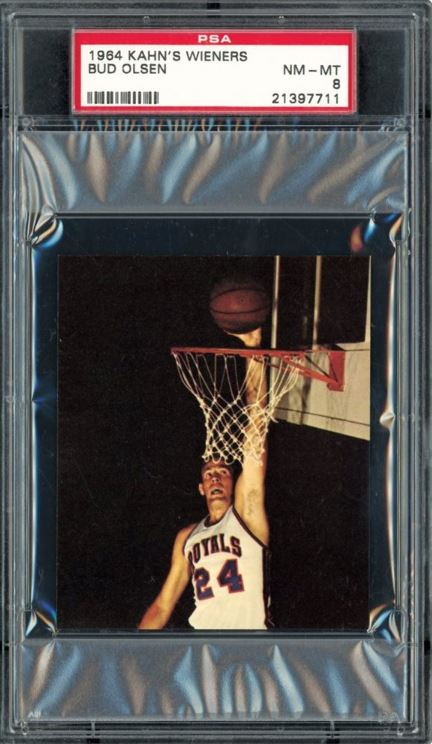
A PSA 7 is worth about $300
Look, I have a weakness for Kahn’s Wiener cards. It probably has to do with my affection for hot dogs. No wonder I am on blood pressure medication. Anyway, they produced some of the best card releases of the 1960s. The 1964 Kahn’s one may not be the most famous, but they are dramatic and beautiful. The cards feature stark black backgrounds, yet the players are well-lit, creating an artsy contrast. That background renders Olsen’s dunk all the more striking. Unfortunately, Bud wasn’t much of a player and I am not sure why Kahn’s selected him among the few players that got cards in this release. I guess this is what happens when a processed meat company selects players. But I am glad they did, because this card absolutely rocks and is eminently affordable.
1961 Fleer Rod Hundley #21
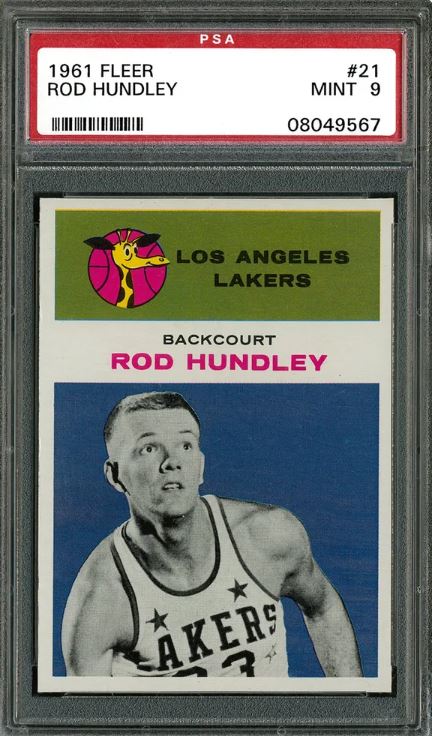
A PSA 8 is worth about $400
Can you believe that old-school Los Angeles Lakers logo? A giraffe in a basketball? What were they thinking? But it's that kind of detail that makes the 1961 Fleer baseketball release so cool. The 1961 Fleer Rod Hundley #21 is one of the most attractive items in this legendary release. Mostly because the action shot catches Rod looking like the All-American hero that he was.
If you don’t know who this player was, Rod Hundley was a college legend. Best known for tremendous ball skills, including a preternatural ability to dribble the ball behind his back, spin it on his finger, and roll the ball down his arm. Hundley was the fourth player to score 2,000 points while averaging 24.5 points and 10.6 rebounds per game. The guard was the No. 1 draft pick in 1957. Unfortunately, bad knees stopped Rod from fulfilling his potential as a pro, but he was a two-time All-Star nonetheless.
1969 Topps Nate Thurmond RC #10
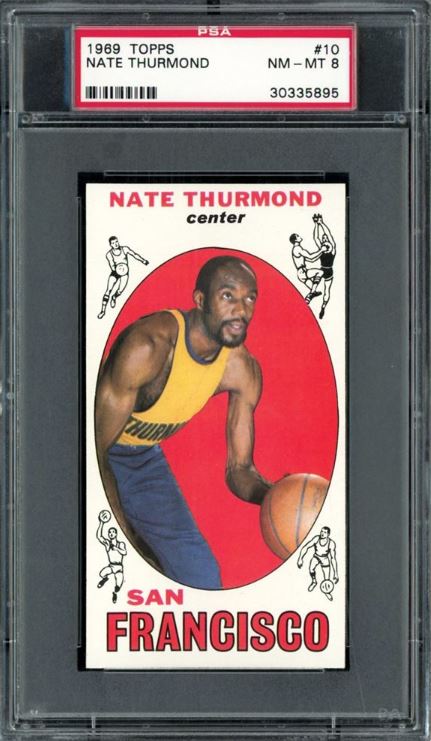
A PSA 8 is worth about $500
Lets face it, Nate Thurmond is ridiculously underrated. How good was the center? “Nate the Great” was the first player to notch a quadruple double, and he once took down 42 rebounds in one game. Indeed, Thurmond was one of the most effective big men to ever dribble a ball, but had the misfortune of playing in the era of Kareem Abdul-Jabar and Wilt Chamberlain. But his entry in the 1969 Topps basketball release is cooler than either of their cards. Yes, I said what I said. Look at how well built and lethal looking our man is on the 1969 Topps Nate Thurmond RC #10 card. Tell me he couldn’t play Shaft? This beautiful baseball card is a rookie of a legendary Hall of Famer and a beautiful item to boot. Current prices are very low when you consider all that.
1969 Topps Earl Monroe #80
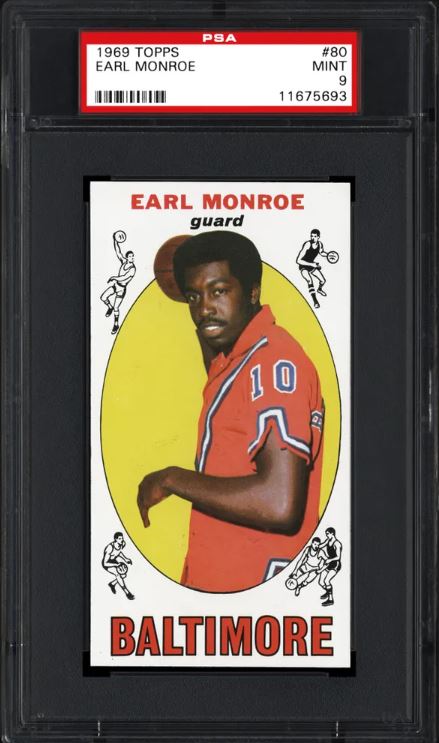
A PSA 8 sells for around $500.
Earl Monroe is such a phenomenally good looking guy, with so much charisma, that even this cheesy pose looks cool. While I am not a big fan of the squiggly basketball player in the corner design of the 1969 Topps basketball cards, the “tall boys” of this series have an iconic status in the hobby. You can just tell Monroe is about to humiliate you in a game of one-on-one.
Of course, the 1969 Topps Earl Monroe #80 has generally been overshadowed by the Lou Alcindor rookie card in this release. But there are many reasons to believe this gorgeous card is going to come out of the shadows. Earl “The Pearl” is already a Hall of Famer and made the top 50 and 75 official NBA lists. He is also a legend among Knicks fans, one of the biggest and most loyal fan bases in the game. Also, not to be too morbid, Monroe is still alive and will gain more recognition and attention when he does pass away. (We love you Earl, stay healthy!)
Therefore, the $500 or so a PSA 8 goes for is incredibly cheap. You already need to fork out $5,000 to get your hands on a PSA 9. However, it is totally worth it considering there are no PSA 10s and their value is sure to appreciate greatly.
1964 Kahn’s Wieners Jerry Lucas (Windows Open)
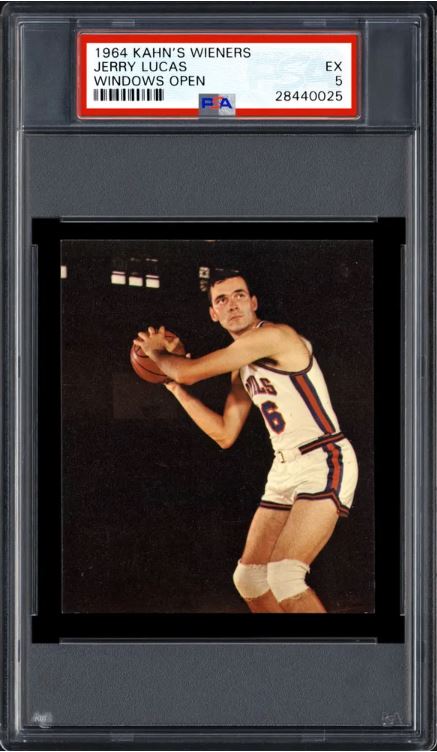
A PSA 7 is worth about $500
To most people, the Jerry Lucas rookie card is the better-known 1969 Topps “Tall Boys” release. But the 1964 Kahn’s Wieners Jerry Lucas card is, of course, an entire half-decade earlier. Sure, some people might say this isn’t a real rookie card because of the release. But to them, I say, you just hate hot dogs, man. And that makes this a very important card. Jerry was one of the most effective forwards in basketball history, making the NBA 75 and ranked 72 all-time by the Athletic. Unfortunately, his career is somewhat overshadowed by players from the more successful Sixers and Celtics. But Jerry did finally win his title with the Knicks in 1973.
To me, this is the most beautiful card of the 1960s. The dramatic pose Jerry takes is contrasted stunningly with the all black background. But the windows open in the top left corner of the card create another level, and an artsy “light at the end of the tunnel” effect. There is also a “no windows visible” version of this. But who wants that? Since this is the first Lucas card, it will almost certainly rise significantly in price.
1969 Topps Willis Reed RC #60
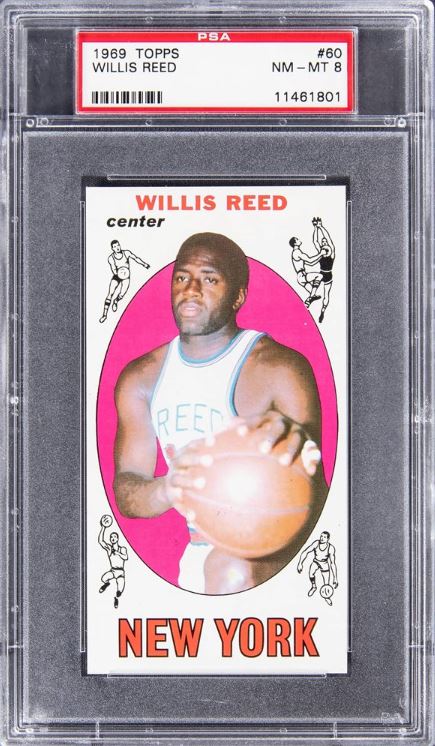
A PSA 8 is worth about $600.
Willis Reed was one of the most talented NBA players ever, but did not reach his fullest potential due to crippling injuries. However, that did not stop Reed from being a Top NBA 75 selection and Hall of Famer. Indeed, “The Captain” only deepened his legend by overcoming terrible pain on numerous occasions. Most famously when Willis hobbled on to the court on Game 7 of the 1970 NBA Finals and inspired the Knicks to the title.
The 1969 Topps Willis Reed RC #60 showcases the strength of spirit that this true champion exemplified. The price of this card has been somewhat depressed by the vast array of great cards in the 1969 Topps “Tall Boys” basketball set. But ultimately, the legend of Willis Reed and the extraodinray striking beauty of this card, sets it apart from the competition. It is a steal at current values.
1961 Fleer Sam Jones #23

A PSA 8 is worth about $800
The 1961 Fleer basketball set has arguably aged more beautifully than any other set for the sport. Sure, it contains some tremendous rookies like Wilt and West. But it's the elegant design that transcends space and time. Something about the juxtaposition between the excellent photographs, solid background, and the prominent classic team logos really pops. The 1961 Fleer Sam Jones #23 really stands out in this regard. It is one of the best photos in the release, featuring an earnest looking Sam, and a perfectly selected orangish background.
And of course, Sam Jones was one of the greatest players of his generation. An essential, yet underrated cog in the 1960s Celtics machine. His darting runs and massive clutch shots helped Boston become the best team in basketball history.
1962 Kahn’s Wieners Wayne Embry
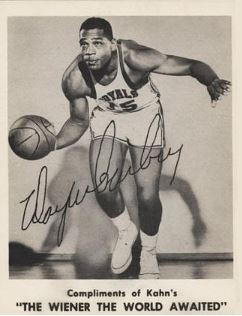
A PSA 9 is worth around $950
The 1962 Kahn’s Wieners Wayne Embry card is poetry in motion. You can say the players of the 1960s didn’t have the athleticism of their modern counterparts. But say that to Wayne Embry’s face. If you dare. Embry is an absolute legend in more than one way. Not only is he a Hall of Famer with 5 All-Star appearances. But Wayne Embry is also an incredible trailblazer, becoming the first African-American executive in NBA history. He could not win a title with his Cincinnati Royals, despite the best efforts of Embry and Jerry Lucas. After all, surpassing the Celtics was almost impossible at the time. But Embry got his when he joined the Celtics in 1968. He then helped the Raptors to a title as an executive. So, when you get this beautiful 1960s basketball card, you are celebrating one of the greatest NBA pioneers.
1963 Kahn’s Wieners Oscar Robertson

A PSA 8 is worth about $1,000.
Strangely enough, the most consistent producer of basketball cards in the 1960s was Kahn’s Wieners. And good news! You can still enjoy a Kahn’s wiener today in select stores near you. Because these releases are little known, they often sell for surprisingly low prices. The gorgeous 1963 Kahn’s Wieners Oscar Robertson is one of those sensational cards with a remarkably low value. So far.
Oscar was remarkably photogenic and had a knack for making the standard awkward basketball card pose look natural and fluid. Therefore, the 1963 Kahn’s Wieners Oscar Robertson, with its faux autograph looks perfect. And man, this card showcases how well the guard was built. Considering the gym facilities of the time, I am impressed.
1964 Topps Test Dave deBusschere #11

A PSA 6 is worth $2,400
The 1968 Topps Test basketball cards are very low numbered, because the company never intended them for release. We still are not sure how they got outo the factory, but we are truly glad they did. They old school black and white design has little to do with the aesthetics of the 1960s. However, they are stunning nonetheless. The set has a good selection of the biggest superstars in the game at that time, and many of the biggest names are completely unaffordable.
However, the 1964 Topps Test Dave deBusschere #11 has not reached the values of say the Bill Russell or Wilt Chamberlain. However, the card is arguably more appealing. The shadow interplay is what turns a simple basketball card into a distinct work of art. The shadow symbolizes the plight of the working class under the wheels of consumer capitalism. Fine, it's just a shadow. But it looks stunning. And of course, Dave was a defensive wizard named among the top 75 NBA players of all time. Since he is an absolute legend and this is a low-numbered release, the value of this beautiful 1960s basketball cardis likely to appreciate considerably.
Final Word On Affordable Yet Beautiful Basketball Cards from the 1960s
1960s basketball cards are not particularly cheap. But luckily, most collectors just focus on the same few rookie cards. But there is a depth and richness to the basketball cards of this era, even though only a limited number of sets were released. It is the lesser known sets like the Kahn’s Wieners and the 1968 Topps Test that really shine, although 1961 Fleer and 1969 Topps are better known classics. Honestly, there is not a single poor design in the entire decade. Every one of these is an absolute gem.
There is also plenty of money to be made here. Many of these Hall of Famer cards are underpriced despite having low population counts. Every card on this list should be worth a good deal more in a decade.